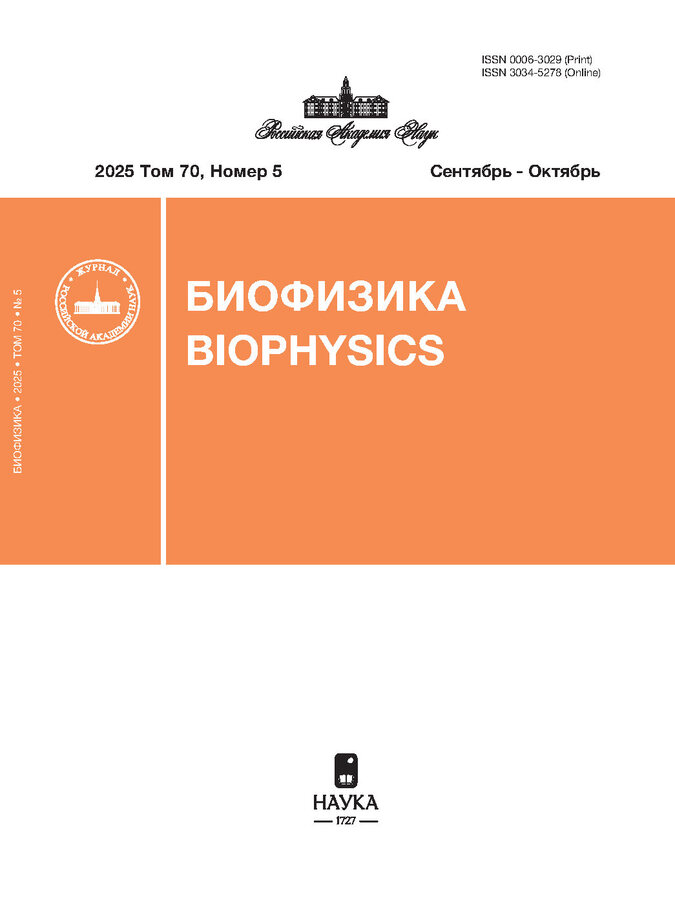Radioprotective Effect of Exogenous Peroxiredoxin 6 in Mice Exposed to Different Doses of Whole-Body Ionizing Radiation
- Authors: Karmanova E.E1, Goncharov R.G1, Bruskov V.I2, Novoselov V.I1, Sharapov M.G1
-
Affiliations:
- Institute of Cell Biophysics, Russian Academy of Sciences
- nstitute of Theoretical and Experimental Biophysics, Russian Academy of Sciences
- Issue: Vol 69, No 6 (2024)
- Pages: 1335-1343
- Section: Complex systems biophysics
- URL: https://gynecology.orscience.ru/0006-3029/article/view/676170
- DOI: https://doi.org/10.31857/S0006302924060195
- EDN: https://elibrary.ru/NJUUBA
- ID: 676170
Cite item
Abstract
Keywords
About the authors
E. E Karmanova
Institute of Cell Biophysics, Russian Academy of SciencesPushchino, Russia
R. G Goncharov
Institute of Cell Biophysics, Russian Academy of Sciences
Email: yanchenkoay@mpei.ru
Pushchino, Russia
V. I Bruskov
nstitute of Theoretical and Experimental Biophysics, Russian Academy of SciencesPushchino, Russia
V. I Novoselov
Institute of Cell Biophysics, Russian Academy of SciencesPushchino, Russia
M. G Sharapov
Institute of Cell Biophysics, Russian Academy of Sciences
Email: sharapov.mg@yandex.ru
Pushchino, Russia
References
- V. L. Martinez Marignac, L. Mondragon, and Favant J. L. Sources of ionizing radiation and their biological effects: An interdisciplinary view, from the physics to cell and molecular biology. Clin. Cancer Investig. J, 8 (4), 129—138 (2019).
- Hirota Y., Masunaga S., Kondo N., Kawabata S., Hirakawa H., Yajima H., Fujimori A., Ono K., Kuroiwa T., and Miyatake S. High linear-energy-transfer radiation can overcome radioresistance of glioma stem-like cells to low linear-energy-transfer radiation. J. Radiat. Res., 55 (1), 75-83 (2014). doi: 10.1093/jrr/rrt095
- Fischer J., Eglinton T. W., Frizelle F. A., and Hampton M. B. Peroxiredoxins in colorectal cancer: predictive biomarkers of radiation response and therapeutic targets to increase radiation sensitivity? Antioxidants (Basel), 7 (10), 136 (2018). doi: 10.3390/antiox7100136
- Checker R., Bhilwade H. N., Nandha S. R., Patwardhan R. S., Sharma D., and Sandur S. K. Withaferin A, a steroidal lactone, selectively protects normal lymphocytes against ionizing radiation induced apoptosis and genotoxicity via activation of ERK/Nrf-2/HO-1 axis. Toxicol. Appl. Pharmacol., 461, 116389 (2023). doi: 10.1016/j.taap.2023.116389
- Zhou T., Zhang L.-Y., He J.-Z., Miao Z.-M., Li Y.-Y., Zhang Y.-M., Liu Z.-W., Zhang S.-Z., Chen Y., Zhou G.-C., and Liu Y.-Q. Review: mechanisms and perspective treatment of radioresistance in non-small cell lung cancer. Front. Immunol., 14, 1133899 (2023). doi: 10.3389/fimmu.2023.1133899
- Porrazzo A., Cassandri M., D'Alessandro A., Morciano P., Rota R., Marampon F., and Cenci G. DNA repair in tumor radioresistance: insights from fruit flies genetics. Cell Oncol. (Dordr.), 47 (3), 717-732 (2024). doi: 10.1007/s13402-023-00906-6
- Obrador E., Salvador R., Villaescusa J. I., Soriano J. M., Estrela J. M., and Montoro A. (2020). Radioprotection and radiomitigation: from the bench to clinical practice. Biomedicines, 8 (11), 461 (2020). doi: 10.3390/biomedicines8110461
- Cerda M. B., Lloyd R., Batalla M., Giannoni F., Casal M., and Policastro, L. Silencing peroxiredoxin-2 sensitizes human colorectal cancer cells to ionizing radiation and oxaliplatin. Cancer Lett., 388, 312-319 (2017). doi: 10.1016/j.canlet.2016.12.009
- Hao J., Song Z., Su J., Li L., Zou L., and Zou K. The PRX-1/TLR4 axis promotes hypoxia-induced radiotherapy resistance in non-small cell lung cancer by targeting the NF-KB/p65 pathway. Cell. Signal., 110, 110806 (2023). doi: 10.1016/j.cellsig.2023.110806
- Li J., Sun Y., Zhao X., Y. Ma, Y. Xie, S. Liu, B. Hui, X. Shi, X. Sun, and Zhang X. Radiation induces IRAK1 expression to promote radioresistance by suppressing autophagic cell death via decreasing the ubiquitination of PRDX1 in glioma cells. Cells Death Dis., 14 (4), 259 (2023). doi: 10.1038/s41419-023-05732-0
- Ding N., Jiang H., Thapa P., Hao Y., Alshahrani A., Allison D., Izumi T., Rangnekar V. M., Liu X., and Wei Q. Peroxiredoxin IV plays a critical role in cancer cell growth and radioresistance through the activation of the Akt/GSK3 signaling pathways. J. Biol. Chem., 298 (7), 102123 (2022). doi: 10.1016/j.jbc.2022.102123
- Аклеев А. В. Радиобиологические закономерности реакции нормальных тканей при лучевой терапии опухолей. Радиац. биол. Радиоэкол., 54 (3), 241 (2014).
- Forshaw T. E., Holmila R., Nelson K. J., Lewis J. E., Kemp M. L., Tsang A. W., Poole L. B., Lowther W. T., and Furdui C. M. Peroxiredoxins in cancer and response to radiation therapies. Antioxidants, 8 (1), 11 (2019). doi: 10.3390/antiox8010011
- Novoselova E. G., Sharapov M. G., Lunin S. M., Parfenyuk S. B., Khrenov M. O., Mubarakshina E. K., Kuzekova A. A., Novoselova T. V., Goncharov R. G., and Glushkova O. V. Peroxiredoxin 6 applied after exposure attenuates damaging effects of X-ray radiation in 3T3 mouse fibroblasts. Antioxidants 10 (12), 1951 (2021). doi: 10.3390/antiox10121951
- Sharapov M. G., Novoselov V. I., and Gudkov S. V. Radioprotective role of peroxiredoxin 6. Antioxidants, 8 (1), 15 (2019). doi: 10.3390/antiox8010015
- Новоселов В. И. Роль пероксиредоксинов при окислительном стрессе в органах дыхания. Пульмонология, 1, 83-87 (2012).
- Sharapov M. G., Goncharov R. G., Parfenyuk S. B., Glushkova O. V., and Novoselov V. I. The role of phospholipase activity of peroxiredoxin 6 in its transmembrane transport and protective properties. Int. J. Mol. Sci., 23 (23), 15265 (2022). doi: 10.3390/ijms232315265
- Salovska B., Kondelova A., Pimkova K., Liblova Z., Pribyl M., Fabrik I., Bartek J., Vajrychova M., and Hodny Z. Peroxiredoxin 6 protects irradiated cells from oxidative stress and shapes their senescence-associated cytokine landscape. Redox Biol. 49, 102212 (2022). doi: 10.1016/j.redox.2021.102212
- Sharapov M. G., Novoselov V. I., Fesenko E. E., Bruskov V. I., and Gudkov S. V. The role of peroxiredoxin 6 in neutralization of X-ray mediated oxidative stress: Effects on gene expression, preservation of radiosensitive tissues and postradiation survival of animals. Free Rad. Res. 51 (2), 148-166 (2017). doi: 10.1080/10715762.2017.1289377
- Sharapov M. G., Novoselov V. I., and Ravin V. K. The cloning, expression, and comparative analysis of peroxiredoxin 6 from various sources. Mol. Biol., 43, 465-471 (2009). doi: 10.1134/S0026893309030145
- Nagataki S. and Takamura N. Radioactive doses - predicted and actual - and likely health effects. Clin. Oncol. (R. Coll. Radiol.), 28 (4), 245-254 (2016). doi: 10.1016/j.clon.2015.12.028
- Jeon J. Review of therapeutic applications of radiolabeled functional nanomaterials. Int. J. Mol. Sci., 20, 2323 (2019). doi: 10.3390/ijms20092323
- Down J. D., Easton D. F., and Steel G. G. Repair in the mouse lung during low dose-rate irradiation. Radiother. Oncol., 6 (1), 29-42 (1986). doi: 10.1016/s0167-8140(86)80107-4
- Thames H. D. An “incomplete-repair” model for survival after fractionated and continuous irradiations. Int. J. Radiat. Biol., 47 (1), 319-339 (1985). doi: 10.1080/09553008514550461
- Richardson R. B. Ionizing radiation and aging: rejuvenating an old idea. Aging (Albany NY), 1 (11), 887-902 (2009). doi: 10.18632/aging.100081
- Kang H., Kim B., Park J., Youn H.-S., and Youn B.-H. The Warburg effect on radioresistance: Survival beyond growth. Biochim. Biophys. Acta, 1878 (6), 188988 (2023). doi: 10.1016/j.bbcan.2023.188988
- Mao G., Yao Y., and Kong Z. Long term exposure to Y-rays induces radioresistance and enhances the migration ability of bladder cancer cells. Mol. Med. Rep., 18 (6), 5834-5840 (2018). doi: 10.3892/mmr.2018.9605
- Chen N., Wu L., Yuan H., and Wang J. ROS/Autopha-gy/Nrf2 pathway mediated low-dose radiation induced radio-resistance in human lung adenocarcinoma A549 cell. Int. J. Biol. Sci., 11 (7), 833-844 (2015). doi: 10.7150/ijbs.10564
- Abad E., Graifer D., and Lyakhovich A. DNA damage response and resistance of cancer stem cells. Cancer Lett., 474, 106-117 (2020). doi: 10.1016/j.canlet.2020.01.008
- Fan M., Ahmed K. M., Coleman M. C., Spitz D. R., and Li J. J. Nuclear factor-кВ and manganese superoxide dismutase mediate adaptive radioresistance in low-dose irradiated mouse skin epithelial cells. Cancer Res., 67 (7), 3220-3228 (2007). doi: 10.1158/0008-5472.CAN-06-2728
- Steel G. G., McMillan T. J., and Peacock J. H. The 5Rs of radiobiology. Int. J. Radiat. Biol., 56 (6), 1045 (1989). doi: 10.1080/09553008914552491
- Villar S. F., Ferrer-Sueta G., and Denicola A. The multifaceted nature ofperoxiredoxins in chemical biology. Curr. Opin. Chem. Biol., 76, 102355 (2023). doi: 10.1016/j.cbpa.2023.102355
- Jeon H.-J., Park Y. S., Cho D.-H., Kim J.-S., Kim E., Chae H. Z., Chun S.-Y., and Oh J. S. Peroxiredoxins are required for spindle assembly, chromosome organization, and polarization in mouse oocytes. Biochem. Biophys. Res. Commun., 489 (2), 193 (2017). doi: 10.1016/j.bbrc.2017.05.127
- Kim Y. J., Lee W. S., Ip C., Chae H. Z., Park E. M., and Park Y. M. Prx1 suppresses radiation-induced c-Jun NH2-terminal kinase signaling in lung cancer cells through interaction with the glutathione S-transferase Pi/c-Jun NH2-terminal kinase complex. Cancer Res., 66 (14), 7136-7142 (2006). doi: 10.1158/0008-5472.CAN-05-4446
- Son Y. W., Cheon M. G., Kim Y., and Jang H. H. Prx2 links ROS homeostasis to stemness of cancer stem cells. Free Radic. Biol. Med., 134, 260-267 (2019).
- M. De Martino, C. Daviaud, E. Hajjar, and C. Vanpouille-Box, Int. Rev. Cell Mol. Biol., 376, 121 (2023). doi: 10.1016/j.freeradbiomed.2019.01.001
- Li H., Benipal B., Zhou S., Dodia C., Chatterjee S., Tao J. Q., Sorokina E. M., Raabe T., Feinstein S. I., and Fisher A. B. Critical role of peroxiredoxin 6 in the repair of peroxidized cell membranes following oxidative stress. Free Radic. Biol. Med., 87, 356-365 (2015). doi: 10.1016/j.freeradbiomed.2015.06.009
- Григорьев П. А., Шарапов М. Г. и Новоселов В. И. Потенциал-зависимые катионные каналы, формируемые пероксиредоксином-6 в липидном бислое. Биофизика, 60 (4), 696-699 (2015).
Supplementary files








